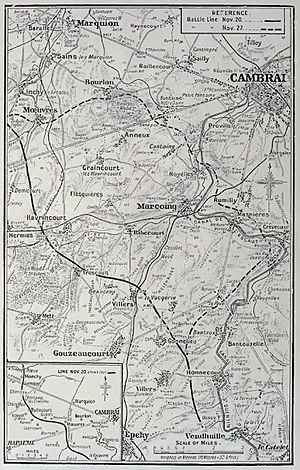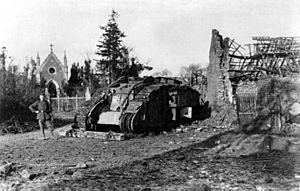Battle of Cambrai facts for kids
Quick facts for kids Battle of Cambrai (1917) |
|||||||||
|---|---|---|---|---|---|---|---|---|---|
| Part of the Western Front of the First World War | |||||||||
 German soldiers recovering a British Mark IV tank |
|||||||||
|
|||||||||
| Belligerents | |||||||||
|
|
|||||||||
| Commanders and leaders | |||||||||
| Strength | |||||||||
| 2 corps 476 tanks (378 combat tanks) |
1 corps | ||||||||
| Casualties and losses | |||||||||
| 75,681 (10,042 killed) 180 tanks |
54,720 (8,817 killed) | ||||||||
The Battle of Cambrai was a major battle during the First World War. It took place near the town of Cambrai in France, from November 20 to December 7, 1917. This battle was important because the British army used a large number of tanks in a surprise attack. It also saw the biggest German counter-attack against the British since 1914.
Cambrai was a key supply hub for the German army. Capturing it and the nearby Bourlon Ridge would have weakened the German defenses. British commanders like Julian Byng decided to combine new ideas. These included using many tanks and special artillery tactics. While tanks had been used before, this battle showed how they could work with infantry and artillery.
The first day was a big success for the British. However, the tanks faced problems like breaking down. German artillery and infantry also fought back strongly. This showed the weaknesses of the Mark IV tank. On the second day, fewer tanks were working, and the British advance slowed down. The battle also showed how different war methods were improving. These included better artillery aiming, new ways for infantry to attack, and air support. The Germans also showed great skill in defending and counter-attacking. This gave them hope that they could win the war before the United States fully joined.
Contents
Planning the Attack
British Strategy for Surprise
The idea for attacking Cambrai with many tanks came from Brigadier Hugh Elles of the Tank Corps. Another key idea came from Henry Hugh Tudor. He was an artillery commander. Tudor suggested a surprise attack using artillery and infantry, supported by a few tanks. The goal was to break through the German Hindenburg Line.
Tudor wanted to use new methods for artillery. These included "sound ranging" and "silent registration." Sound ranging helped locate enemy guns. Silent registration meant setting up guns without firing them first. This kept the attack a secret. Tanks were also meant to clear paths through thick barbed wire. They would also help by exploding shells without making big holes in the ground.
Air Support for the Attack
The Royal Flying Corps (RFC) was the British air force. Two weeks before the battle, RFC pilots practiced attacking targets on the ground. Their missions included hitting trenches, supply points, and enemy airfields. This was to help the ground troops during the battle.
The Battle Begins
British Attack on the Third Army Front
The battle started early on November 20, at about 6:30 AM. Over 1,000 British guns fired at German defenses. Smoke was used to hide the advancing troops. A moving wall of shells, called a "creeping barrage," moved ahead of the soldiers. Even with efforts to keep it secret, the Germans knew an attack was coming. They expected an attack near Havrincourt and knew tanks might be used.
The British attacking force included six infantry divisions and nine tank battalions. They had about 437 tanks. At first, the attack was very successful in many areas. It seemed like a huge victory was possible.
The main British goal was to capture Bourlon Ridge. On November 23, the 40th Division attacked the woods on Bourlon Ridge. They had almost 100 tanks and 430 guns helping them. But they made little progress. The Germans had sent many soldiers to defend the ridge.
The 40th Division reached the top of the ridge but could not move further. They lost over 4,000 soldiers in three days. More British troops were sent in, but their reserves quickly ran out. More German soldiers kept arriving. The last British push was on November 27, with 30 tanks helping. They had early success, but a German counter-attack soon pushed them back.
On November 28, the British stopped their attack. They were told to set up barbed wire and dig defensive positions. The Germans quickly focused their artillery on these new British lines. On that day, over 16,000 shells hit the woods.
German Counter-Attack
As the British fought for the ridge, German reinforcements arrived. By November 23, the Germans felt they had stopped the British breakthrough. They began planning their own counter-attack. Twenty German divisions gathered near Cambrai. Their plan was to take back Bourlon Ridge and attack around Havrincourt. They hoped to at least reach their old positions on the Hindenburg Line.
The German attack began at 7:00 AM on November 30. Many British divisions were immediately in heavy fighting. The German infantry advanced very quickly in the south. Some British commanders barely escaped capture. One general had to fight his way out of his headquarters. He gathered retreating soldiers to try and stop the Germans. In the south, the German advance covered about 13 kilometers (8 miles). They came close to the village of Metz.
At Bourlon, the Germans lost many soldiers. British units fought with great determination to hold the ridge. This strong defense helped the Germans advance more easily elsewhere. Only quick counter-attacks by British Guards divisions and the arrival of tanks helped hold the line until nightfall. By the next day, the German advance had slowed. But on December 3, the Germans captured La Vacquerie. The British had to pull back from the east bank of the St Quentin canal.
By December 7, the British gave up most of the land they had gained. They only kept a small part of the Hindenburg Line around Havrincourt, Ribécourt, and Flesquières. The Germans had gained a slightly smaller area to the south.
Battle Losses
The Battle of Cambrai resulted in many casualties for both sides. British forces lost about 75,681 soldiers. This included 10,042 killed, 48,702 wounded, and 16,987 missing or captured. Around 180 British tanks were destroyed.
German forces lost about 54,720 soldiers. This included 8,817 killed, 22,931 wounded, and 22,972 missing or captured. The way each side counted casualties was a bit different. The British counted daily, while the Germans counted patients in hospitals every ten days. This meant the German numbers might not include soldiers with light wounds who returned to duty quickly.
Remembering the Battle
Memorials and Cemeteries
The Royal Tank Regiment remembers the Battle of Cambrai every year on "Cambrai Day." This is a very important event for them. The contributions of the Newfoundland Regiment are honored at the Masnières Newfoundland Memorial. The Indian Army's 2nd Lancers (GH) also celebrate Cambrai Day. This is because Lance Dafadar Gobind Singh from their unit won the Victoria Cross during this battle.
The town of Cambrai in Australia was renamed in 1917. It used to be called Rhine Villa. This was one of many Australian place names changed from German names during the First World War. In Germany, a military base in Darmstadt was named "Cambrai-Fritsch Kaserne" after the battle. The United States Army used this base after World War II until 2008.
British Burial Sites
The Commonwealth War Graves Commission maintains four memorials and cemeteries for Commonwealth soldiers who died at Cambrai:
- Cambrai Memorial to the Missing: This monument lists 7,048 missing soldiers from the United Kingdom and South Africa. They died and have no known graves.
- Flesquieres Hill British Cemetery: About 900 soldiers are buried here. One-third of them are unidentified.
- Orival Wood Cemetery: About 200 soldiers are buried here.
- Hermies Hill British Cemetery: About 1,000 soldiers are buried here.
German Burial Sites
The German War Cemetery on the Route de Solesmes was set up in May 1917. It holds the remains of 10,685 German soldiers and 501 British soldiers.
 In Spanish: Batalla de Cambrai para niños
In Spanish: Batalla de Cambrai para niños





